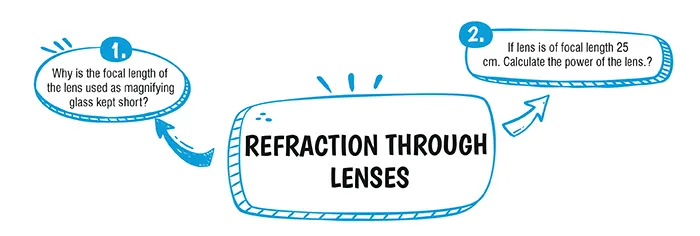Table of Contents

Ans. (a)
Explanation:
The image formed is real since (v is positive), inverted (as all real images formed by a convex lens are inverted when the object is placed beyond the focus), and located slightly beyond the point which is twice the focal length (i.e., slightly beyond 40cm) on the opposite side of the lens from the object.
Ans. (b)
Explanation:
A plano-convex lens is a type of lens where one side is flat (plane) and the other side curved outward (convex).plano-convex lens is a versatile optical component with a range of applications in various optical systems and instruments. The choice to use this type of lens often comes down to specific system requirements and design considerations.
Explanation:
The focal length of the lens used as magnifying glass is kept small to increase its magnifying power. A magnifying glass, which is essentially a simple convex lens, is used to magnify small objects or fine details in objects. The magnifying power (or angular magnification) of a simple convex lens when used as a magnifying glass is related to its focal length.

Explanation:
The complete diagram is shown in the below figure in which the position of lens has been marked by the letter LL′. and the focus as F. The lens is convex (or converging).

Explanation:
Focal length = 25 cm = 0.25 m
For a converging lens (like a convex lens), the focal length is positive, so its power is also positive. For a diverging lens (like a concave lens), the focal length is negative, so its power is negative.
This relationship implies that a lens with a short focal length has a high power, and a lens with a long focal length has low power.
Download Mind Map of this chapter
Download NowWant to Practice Mock Tests of this chapter
Practice NowDownload Important Questions of this chapter
Download Now| Chapter No. | Chapter Name |
|---|---|
| Chapter 1 | Force Work Power and Energy |
| Chapter 2 | Simple Machines |
| Chapter 3 | Refraction of Light |
| Chapter 4 | Refraction Through Lenses |
| Chapter 5 | Spectrum |
| Chapter 6 | Sound |
| Chapter 7 | Electricity |
| Chapter 8 | Electrical Power and Household Circuits |
| Chapter 11 | Magnetic Effect of Current |
| Chapter 12 | Specific Heat Capacity and Latent Heat |
| Chapter 13 | Radioactivity and Nuclear Energy |
| Chapter Wise Important Questions for ICSE Board Class 10 Physics |
|---|
| Force Work Power and Energy |
| Simple Machines |
| Refraction of Light |
| Refraction Through Lenses |
| Spectrum |
| Sound |
| Electricity |
| Electrical Power and Household Circuits |
| Magnetic Effect of Current |
| Specific Heat Capacity and Latent Heat |
| Radioactivity and Nuclear Energy |
CBSE Important Questions Class 10
ICSE Important Questions Class 10
CBSE Important Questions Class 10
ICSE Important Questions Class 10